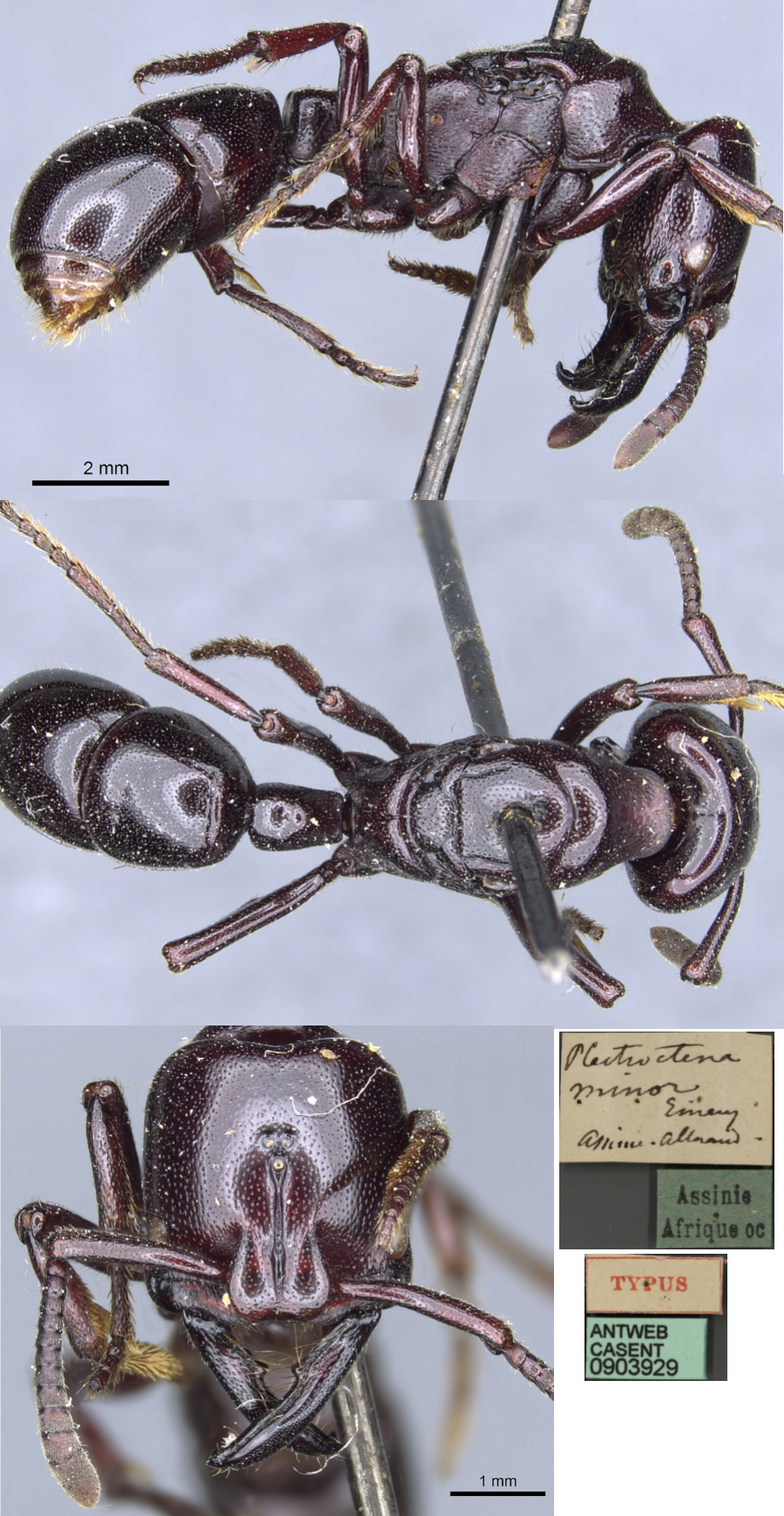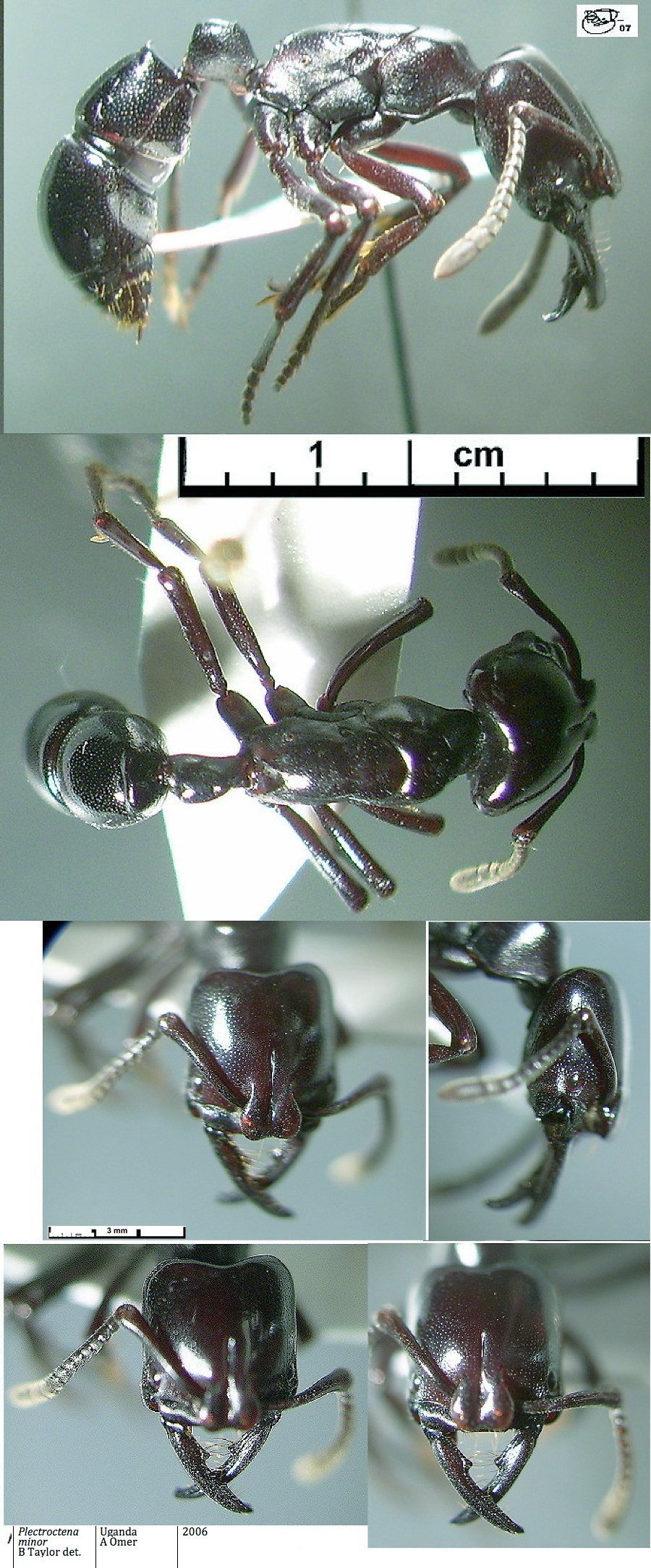Plectroctena minor Emery
  Type location Ivory Coast
(Plectroctena minor n. sp.,
Emery, 1892d: 556, illustrated, queen - see below; Emery, 1902c: 32,
worker;
Wheeler, 1922: 88, male) Assinie Type location Ivory Coast
(Plectroctena minor n. sp.,
Emery, 1892d: 556, illustrated, queen - see below; Emery, 1902c: 32,
worker;
Wheeler, 1922: 88, male) Assinie
junior synonyms
insularis (Plectroctena
minor Em. v. insularis
n. var., Santschi, 1924a: 169, illustrated, worker) from Fernando
Po I., Conrad - see http://www.antweb.org/specimenImages.do?name=casent0915288&project=allantwebants
where labelled "fernandensis"
liberiana (Plectroctena
minor Em. v. liberiana
n. var., Santschi, 1924a: 169, illustrated, worker) from Liberia
- see http://www.antweb.org/specimenImages.do?code=casent0915291
perusta (Plectroctena
minor Em. v. perusta
n. var., Santschi, 1924a: 168, illustrated, worker) from Cameroun,
Barumbistation, Preuss - see http://www.antweb.org/specimenImages.do?code=casent0104650
all forms described (see Bolton, 1995)  . .
|
 Emery's (1892d) illustrated description of the queen is
at Emery's (1892d) illustrated description of the queen is
at  Emery's (1902c) description of the worker
is at Emery's (1902c) description of the worker
is at  Santschi's (1924a) description of the
species s.s. is at Santschi's (1924a) description of the
species s.s. is at  and those of perusta,
liberiana and insularis are at and those of perusta,
liberiana and insularis are at  . Bolton's modern description (1974b: 324,
mandible and petiole profile) is at . Bolton's modern description (1974b: 324,
mandible and petiole profile) is at  . .
|
Plectroctena gabonensis Santschi - Type location Gabon
(Plectroctena
gabonensis n.
sp., Santschi, 1919a: 336, worker; Bolton, 1974b: 323, queen)
Libreville, Chalot - see http://www.antweb.org/specimenImages.do?code=casent0915472
Worker and
queen described (Bolton, 1974b, not illustrated)  .
Note - Bolton & Brown (2002: 11) revised
this to
a junior synonym of minor. .
Note - Bolton & Brown (2002: 11) revised
this to
a junior synonym of minor.
|
Santschi's (1919a) description is at  . Bolton's modern description (1974b) is at . Bolton's modern description (1974b) is at

WORKER - TL 12.8-14.0 mm; similar to minor but
slightly smaller; first gastral tergite with transverse groove very
weak, usually only visible in middle of sclerite; eye smaller. Colour
deep red-brown (minor is black).
Original collection from Libreville, Gabon, by Chalot,
1.xii.1897.
Bolton (1974b) lists records from Gabon, Equatorial
Guinea
(Fernando Po I.) and Zaïre - 6 findings. Now known from Cameroun,
collected by the Campo Forest study (Bolton, Dejean & Ngnegueu,
1992), four samples, two from soil, one from rotting wood and one from
an abandoned termitarium of Cubitermes banksi.
|
 The
photomontage of the type queen is collated from http://www.antweb.org/specimen.do?name=casent0903929. The
photomontage of the type queen is collated from http://www.antweb.org/specimen.do?name=casent0903929.
|
 The
photomontage of the type worker of liberiana is collated from http://www.antweb.org/specimen.do?name=casent0915291. The
photomontage of the type worker of liberiana is collated from http://www.antweb.org/specimen.do?name=casent0915291.
|
 Nigeria specimen (Taylor, 1976: 29). WORKER. TL
14.38 mm, HL 3.23, HW 3.17, SL 2.15, PW 1.90 Nigeria specimen (Taylor, 1976: 29). WORKER. TL
14.38 mm, HL 3.23, HW 3.17, SL 2.15, PW 1.90
Colour dark red-brown, shiny. All over sculpturation of scattered small
hair-pits, very faint striations on the lateral alitrunk and petiole.
Collected from a rotten log by Bolton at the Cocoa Research Institute
of Nigeria, Idi Ayunre. He noted that fragments of millipedes were
among the detritus of an excavated nest. Others TL 15.2-17.6, and
otherwise generally larger, and darker (Bolton, 1974b).
Original collection from Assinie, Ivory Coast, by Ch.
Alluaud, vii-viii 1886. The collection of perusta was at
Barumbistation, Cameroun, by Preuss.
Wheeler (1922) listed it also from Sierra Leone
(no details), Ghana (Aburi, F. Silvestri), Cameroun (Victoria,
F. Silvestri), plus Fernando Po and Zaïre.
Bolton (1974b) also found it in Ghana, at CRIG,
and it was described as not uncommon in eastern Ghana (Belshaw &
Bolton, 1994b), although not found by them.
After examining further material from - Ghana, at Tafo,
Wiawso and Odomi River, by D. Leston; Togo, at Palimé, Klouto,
by Vir; Cameroun, at Ottotomo, Ndupe and Nzi, by A. Dejean, and
Nkoemvon, by D. Jackson; Gabon, La Fôret des Abeilles, by S.
Lewis; and Zaïre, Kinzambi, by A. Dejean; Bolton & Brown (2002)
concluded the variations previously used to separate minor and gabonensis
were insufficiently consistent to justify the separation into two
species. They placed gabonensis as a junior synonym of minor.
|
 Working with colonies established from field
populations in the Kala, Matomb (Pan Pan), Ndupé and Ottotomo forests
of southern Cameroun, Suzzoni, Schatz & Dejean (2000) used a
cafeteria method of investigating the preferred prey of this species
and conclusively demonstrated the "essential" nature of millipedes,
with other arthropods being ancillary. Without millipedes in the diet
of larvae in large colonies of P. minor winged females were not
produced and the production of workers was reduced. The absence of
millipedes, however, did not appear to affect the production of males.
Foundling queens, avoiding tackling large prey and the illustration
(right) from their paper shows such a queen with a woodlouse. They
described how normal foraging is under the bark and in the wood of the
rotting logs, which also are used as the nest sites. Working with colonies established from field
populations in the Kala, Matomb (Pan Pan), Ndupé and Ottotomo forests
of southern Cameroun, Suzzoni, Schatz & Dejean (2000) used a
cafeteria method of investigating the preferred prey of this species
and conclusively demonstrated the "essential" nature of millipedes,
with other arthropods being ancillary. Without millipedes in the diet
of larvae in large colonies of P. minor winged females were not
produced and the production of workers was reduced. The absence of
millipedes, however, did not appear to affect the production of males.
Foundling queens, avoiding tackling large prey and the illustration
(right) from their paper shows such a queen with a woodlouse. They
described how normal foraging is under the bark and in the wood of the
rotting logs, which also are used as the nest sites.
|
Oxford University Museum
specimens
Plectroctena minor
B Taylor det.
|
Uganda
A Omer
|
2006
|
Hnad collected
|
1
|
 |
Plectroctena minor
B Taylor det. |
Central African
Republic
P Annoyer
|
06.vi.1998
Dzanga-Sangha
02°53’ N
16°15’ E
|
Bayanga-Lidjomba
|
2
|
 |
|
 The photomontage is of a
worker from Uganda, collector Awatif
Omer, 2006. The photomontage is of a
worker from Uganda, collector Awatif
Omer, 2006.
|
 The
photomontage is of a worker from the Central African Republic,
Dzanga-Sangha NP; Bayanga-Lidjombo; 07.vi.1998; 10.30-12.30 h,
collector Philippe Annoyer. The
photomontage is of a worker from the Central African Republic,
Dzanga-Sangha NP; Bayanga-Lidjombo; 07.vi.1998; 10.30-12.30 h,
collector Philippe Annoyer.
|
 The
photomontage is collated from http://www.antweb.org/specimen.do?name=casent0003067.
The specimen is from Gabon, Woleu-Ntem; 31.3 km 108° ESE
Minvoul; 02°04'48"N 012°24'24"E; 600m; B L Fisher, BLF1673; rotten log
in rain forest; 10.ii.1998. The
photomontage is collated from http://www.antweb.org/specimen.do?name=casent0003067.
The specimen is from Gabon, Woleu-Ntem; 31.3 km 108° ESE
Minvoul; 02°04'48"N 012°24'24"E; 600m; B L Fisher, BLF1673; rotten log
in rain forest; 10.ii.1998.
|
|